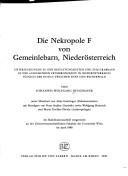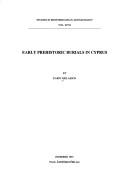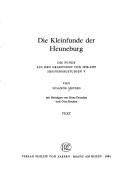| Listing 1 - 10 of 155 | << page >> |
Sort by
|
Book
ISBN: 3515024905 Year: 1985 Volume: 9 Publisher: Wiesbaden Steiner
Abstract | Keywords | Export | Availability | Bookmark
 Loading...
Loading...Choose an application
- Reference Manager
- EndNote
- RefWorks (Direct export to RefWorks)
Burial --- Sépulture --- Manching (Germany) --- Manching (Allemagne) --- Antiquities --- Antiquités --- -Burial customs --- Burying-grounds --- Graves --- Interment --- Archaeology --- Public health --- Coffins --- Dead --- Funeral rites and ceremonies --- Grave digging --- -Antiquities --- Antiquities. --- -Manching (Germany) --- Sépulture --- Antiquités --- Burial customs

ISBN: 3805311915 Year: 1991 Publisher: Mainz am Rhein von Zabern
Abstract | Keywords | Export | Availability | Bookmark
 Loading...
Loading...Choose an application
- Reference Manager
- EndNote
- RefWorks (Direct export to RefWorks)
Bronze age --- -Burial --- -Burial customs --- Burying-grounds --- Graves --- Interment --- Archaeology --- Public health --- Coffins --- Dead --- Funeral rites and ceremonies --- Grave digging --- Civilization --- Gemeinlebarn (Austria) --- -Austria --- Antiquities --- Antiquities. --- Burial --- -Gemeinlebarn (Austria) --- Burial customs --- Austria
Book
ISBN: 0860547256 Year: 1991 Publisher: Oxford Tempus reparatum
Abstract | Keywords | Export | Availability | Bookmark
 Loading...
Loading...Choose an application
- Reference Manager
- EndNote
- RefWorks (Direct export to RefWorks)
Burial --- Romans --- History --- Burial customs --- Burying-grounds --- Graves --- Interment --- Archaeology --- Public health --- Coffins --- Dead --- Funeral rites and ceremonies --- Grave digging --- Great Britain --- Antiquities, Roman.
Book
ISBN: 1407315307 9781407315300 Year: 2016 Publisher: Oxford British Archaeological Reports
Abstract | Keywords | Export | Availability | Bookmark
 Loading...
Loading...Choose an application
- Reference Manager
- EndNote
- RefWorks (Direct export to RefWorks)
Burial --- Funeral rites and ceremonies --- Bronze age --- Iron age --- History. --- Great Britain --- Antiquities. --- Burial customs --- Burying-grounds --- Graves --- Interment --- Archaeology --- Public health --- Coffins --- Dead --- Grave digging
Book
ISBN: 3319423843 3319423835 Year: 2017 Publisher: Cham : Springer International Publishing : Imprint: Springer,
Abstract | Keywords | Export | Availability | Bookmark
 Loading...
Loading...Choose an application
- Reference Manager
- EndNote
- RefWorks (Direct export to RefWorks)
This book proposes a new model and scheme of analysis for complex burial material and applies it to the prehistoric archaeological record of the Liangshan region in Southwest China that other archaeologists have commonly given a wide berth, regarding it as too patchy, too inhomogeneous, and overall too unwieldy to work with. The model treats burials as composite objects, considering the various elements separately in their respective life histories. The application of this approach to the rich and diverse archaeological record of the Liangshan region serves as a test of this new form of analysis. This volume thus pursues two main aims: to advance the understanding of the archaeology of the immediate study area which has been little examined, and to present and test a new scheme of analysis that can be applied to other bodies of material.
Burial --- History. --- Burial customs --- Burying-grounds --- Graves --- Interment --- Archaeology --- Public health --- Coffins --- Dead --- Funeral rites and ceremonies --- Grave digging --- Archaeology. --- Archeology --- Anthropology --- Auxiliary sciences of history --- History --- Antiquities
Book
ISBN: 0701106654 Year: 1970 Publisher: London Chatto and Windus
Abstract | Keywords | Export | Availability | Bookmark
 Loading...
Loading...Choose an application
- Reference Manager
- EndNote
- RefWorks (Direct export to RefWorks)
Burial --- Death --- Burial customs --- Burying-grounds --- Graves --- Interment --- Archaeology --- Public health --- Coffins --- Dead --- Funeral rites and ceremonies --- Grave digging --- Fiction --- Mississippi --- Fiction. --- American literature
Book
ISBN: 1108472834 1108690904 1108639933 1108586163 Year: 2019 Publisher: Cambridge : Cambridge University Press,
Abstract | Keywords | Export | Availability | Bookmark
 Loading...
Loading...Choose an application
- Reference Manager
- EndNote
- RefWorks (Direct export to RefWorks)
The history of funerary customs in Rome contains many unanswered questions and controversial debates, especially concerning the significant developments of the second century CE. In this book, distinguished historian Barbara E. Borg employs the full range of material and written evidence to explore four key questions that change our view of Roman society and its values. For the first time, senatorial burial practices can be reconstructed and contrasted with those of other classes. Borg then explains the change from incineration to inhumation as a revival of old Roman mores that accelerated after the example set by Hadrian. In the third chapter, she argues that tombs became prime locations for promoting and displaying long family lines among the elite, which then inspired freedmen to undertake similar commemorative practices. Finally she explores the association of deceased persons with the divine and apotheosis through portraits on divine body shapes and temple tombs.
Funeral rites and ceremonies --- Burial --- Tombs --- Sepulchral monuments --- Rome --- History --- Burial customs --- Burying-grounds --- Graves --- Interment --- Archaeology --- Public health --- Coffins --- Dead --- Grave digging --- Funeral rites and ceremonies, Roman
Book
ISBN: 1299559107 Publisher: Sidestone Press
Abstract | Keywords | Export | Availability | Bookmark
 Loading...
Loading...Choose an application
- Reference Manager
- EndNote
- RefWorks (Direct export to RefWorks)
Some 2800 years ago, a man died in what is now the municipality of Oss, the Netherlands. His death must have been a significant event in the life of local communities, for he received an extraordinary funeral, which ended with the construction of an impressive barrow. Based on the meticulous excavation and a range of specialist and comprehensive studies of finds, a prehistoric burial ritual now can be brought to life in surprising detail. An Iron Age community used extraordinary objects that find their closest counterpart in the elite graves of the Hallstatt culture in Central Europe. This book will discuss how lavishly decorated items were dismantled and taken apart to be connected with the body of the deceased, all to be destroyed by fire. In what appears to be a meaningful pars pro toto ritual, the remains of his body, the pyre, and the objects were searched through and moved about, with various elements being manipulated, intentionally broken, and interred or removed. In essence, a person and a place were transformed through destruction. The book shows how the mourners carefully, almost lovingly covered the funeral remains with a barrow. Attention is also given to another remarkable monument, long mound 6, located immediately adjacent to mound 7. Excavations show how mound 7 was part of an age-old ritual heath landscape that was entirely restructured during the Early Iron Age, when it became the setting for the building of no less than three huge Hallstatt C barrows. Thousands of years later, during the Late Middle Ages, this landscape underwent a complete transformation of meaning when the prehistoric barrows became the scenery for a macabre display of the cadavers of executed criminals. This publication is part of the Ancestral Mounds Research Project of the University of Leiden.
Excavations (Archaeology) --- Burial --- Iron age --- Civilization --- Burial customs --- Burying-grounds --- Graves --- Interment --- Archaeology --- Public health --- Coffins --- Dead --- Funeral rites and ceremonies --- Grave digging

ISBN: 9170810214 9789170810213 Year: 1991 Volume: 96 Publisher: Jonsered Åström
Abstract | Keywords | Export | Availability | Bookmark
 Loading...
Loading...Choose an application
- Reference Manager
- EndNote
- RefWorks (Direct export to RefWorks)
Neolithic period --- Copper age --- Burial --- -Copper age --- -Burial --- -Burial customs --- Burying-grounds --- Graves --- Interment --- Archaeology --- Public health --- Coffins --- Dead --- Funeral rites and ceremonies --- Grave digging --- Chalcolithic age --- Copper-stone age --- Cyprolithic age --- Eneolithic age --- Antiquities, Prehistoric --- Civilization --- New Stone age --- Stone age --- Cyprus --- Antiquities. --- -Cyprus --- Burial customs --- Tombs --- Antiquities --- Neolithic period - Cyprus. --- Copper age - Cyprus. --- Burial - Cyprus.

ISBN: 3805307705 Year: 1984 Volume: 5 Bd. 42 Publisher: Mainz am Rhein : von Zabern,
Abstract | Keywords | Export | Availability | Bookmark
 Loading...
Loading...Choose an application
- Reference Manager
- EndNote
- RefWorks (Direct export to RefWorks)
Burial --- Excavations (Archaeology) --- Heuneburg Site (Germany) --- Germany (West) --- Allemagne (Ouest) --- Antiquities --- Antiquités --- -Excavations (Archaeology) --- -Hallstatt period --- -Iron age --- Burial customs --- Burying-grounds --- Graves --- Interment --- Archaeology --- Public health --- Coffins --- Dead --- Funeral rites and ceremonies --- Grave digging --- Germany --- Hallstatt period --- -Heuneburg Site (Germany) --- Heuneburg Site (Germany). --- Antiquités --- -Burial customs
| Listing 1 - 10 of 155 | << page >> |
Sort by
|

 Search
Search Feedback
Feedback About UniCat
About UniCat  Help
Help News
News